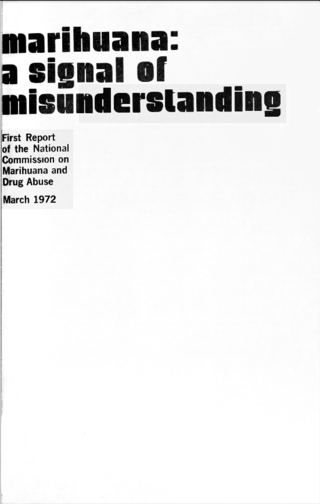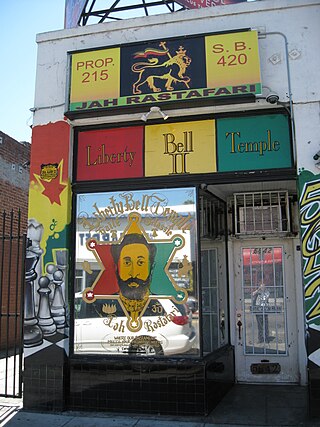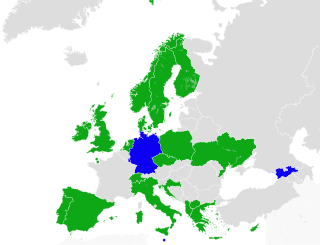
Cannabis is a genus of flowering plants in the family Cannabaceae. The number of species within the genus is disputed. Three species may be recognized: Cannabis sativa, C. indica, and C. ruderalis. Alternatively, C. ruderalis may be included within C. sativa, all three may be treated as subspecies of C. sativa, or C. sativa may be accepted as a single undivided species. The genus is widely accepted as being indigenous to and originating from Asia.

Tetrahydrocannabinol (THC) is a cannabinoid found in cannabis. It is the principal psychoactive constituent of cannabis and one of at least 113 total cannabinoids identified on the plant. Its chemical formula C21H30O2 includes compounds, the term THC usually refers to the delta-9-THC isomer with chemical name (−)-trans-Δ9-tetrahydrocannabinol. It is a colorless oil.

Medical cannabis, medicinal cannabis or medical marijuana (MMJ), is cannabis and cannabinoids that are prescribed by physicians for their patients. The use of cannabis as medicine has not been rigorously tested due to production and governmental restrictions, resulting in limited clinical research to define the safety and efficacy of using cannabis to treat diseases.

Cannabis, also known as marijuana or weed, among other names, is a non-chemically uniform drug from the cannabis plant. Native to Central or South Asia, the cannabis plant has been used as a drug for both recreational and entheogenic purposes and in various traditional medicines for centuries. Tetrahydrocannabinol (THC) is the main psychoactive component of cannabis, which is one of the 483 known compounds in the plant, including at least 65 other cannabinoids, such as cannabidiol (CBD). Cannabis can be used by smoking, vaporizing, within food, or as an extract.

The Shafer Commission, formally known as the National Commission on Marihuana and Drug Abuse, was appointed by U.S. President Richard Nixon in the early 1970s. Its chairman was former Pennsylvania Governor Raymond P. Shafer. The commission issued a report on its findings in 1972 that called for the decriminalization of marijuana possession in the United States. The report was ignored by the White House, but is an important document against prohibition.

Different religions have varying stances on the use of cannabis, historically and presently. In ancient history some religions used cannabis as an entheogen, particularly in the Indian subcontinent where the tradition continues on a more limited basis.

In the United States, increased restrictions and labeling of cannabis as a poison began in many states from 1906 onward, and outright prohibitions began in the 1920s. By the mid-1930s cannabis was regulated as a drug in every state, including 35 states that adopted the Uniform State Narcotic Drug Act. The first national regulation was the Marihuana Tax Act of 1937.

Marijuana, or marihuana, is a name for the cannabis plant, and more specifically, a drug preparation from it. "Marijuana" as a term varies in usage, definition and legal application around the world. Some jurisdictions define "marijuana" as the whole cannabis plant or any part of it, while others refer to "marijuana" as a portion of the cannabis plant that contains high levels of tetrahydrocannabinol (THC). Some jurisdictions recognize "marijuana" as a distinctive strain of cannabis, the other being hemp. For legal, research and statistical reference, "marijuana" generally refers to only the dried leaves and flowering tops, with by-products such as hashish or hash oil being uniquely defined and regulated. The form "marihuana" is first attested in Mexican Spanish; it then spread to other varieties of Spanish and to English, French, and other languages.
The Industrial Hemp Farming Act of 2009, introduced during the 111th United States Congress by House Republican Ron Paul of Texas) and House Democrat Barney Frank of Massachusetts) on April 2, 2009, sought to clarify the differences between marijuana and industrial hemp as well as repeal federal laws that prohibit cultivation of industrial, but only for research facilities of higher education from conducting research. Industrial hemp is the non-psychoactive, low-THC, oil-seed and fibers varieties of, predominantly, the cannabis sativa plant. Hemp is a sustainable resource that can be used to create thousands of different products including fuel, fabrics, paper, household products, and food and has been used for hundreds of centuries by civilizations around the world. If H.R.1866 passes American farmers will be permitted to compete in global hemp markets. On March 10, 2009, both Paul and Frank wrote a letter to their Congressional colleagues urging them to support the legislation. This bill was previously introduced in 2005 under the title of Industrial Hemp Farming Act of 2005.
The history of medicinal cannabis goes back to the ancient times. Ancient physicians in many parts of the world mixed cannabis into medicines to treat pain and other ailments. In the 19th century, cannabis was introduced for therapeutic use in Western Medicine. Since then, there have been several advancements in how the drug is administered. Initially, cannabis was reduced to a powder and mixed with wine for administration. In the 1970s, synthetic THC was created to be administered as the drug Marinol in a capsule. However, the main mode of administration for cannabis is smoking because its effects are almost immediate when the smoke is inhaled. Between 1996 and 1999, eight U.S. states supported cannabis prescriptions opposing policies of the federal government. Most people who are prescribed marijuana for medical purposes use it to alleviate severe pain.

Psychoactive plants are plants, or preparations thereof, that upon ingestion induce psychotropic effects. As stated in a reference work:
Psychoactive plants are plants that people ingest in the form of simple or complex preparations in order to affect the mind or alter the state of consciousness.

Although Cannabis use is illegal in Egypt, it is often used privately by many. Law enforcements are often particularly lax when it comes to cannabis smokers, and its use is a part of the common culture for many people in Egypt. However, Large-scale smuggling of cannabis is punishable by death, while penalties for possessing even small amounts can also be severe. Despite this, these laws are not enforced in many parts of Egypt, where cannabis is often consumed openly in local cafes.

Cannabis in Greece is illegal for recreational purposes. In 2017, the Greek government legalized the use of cannabis for medical purposes, and a year later, they lifted the ban on growing or producing it. This enables pharmaceutical companies to grow cannabis legally, and industrial hemp suppliers too.

Cannabis is illegal in Pakistan for recreational use, although since September 2020, extracts of cannabis can be used for industrial and medical use. Cannabis is widely consumed in Pakistan as charas and bhang.
The list includes and details significant events that occurred in the global history of national-level implementations of, or changes made to, laws surrounding the use, sale, or production of the psychoactive drug cannabis.

Cannabis is illegal in China except for industrial purposes (hemp) and some forms of medicine. Historically, cannabis has been used in China for fiber, seeds, as a traditional medicine, as well as for some ritual purposes within Taoism.

Cannabis has served as an entheogen—a chemical substance used in religious or spiritual contexts—in the Indian subcontinent since the Vedic period dating back to approximately 1500 BCE, but perhaps as far back as 2000 BCE. It was introduced to the New World by the Spaniards in 1530-1545.

Terms related to cannabis include:

The history of cannabis and its usage by humans dates back to at least the third millennium BC in written history, and possibly as far back as the Pre-Pottery Neolithic B based on archaeological evidence. For millennia, the plant has been valued for its use for fiber and rope, as food and medicine, and for its psychoactive properties for religious and recreational use.














